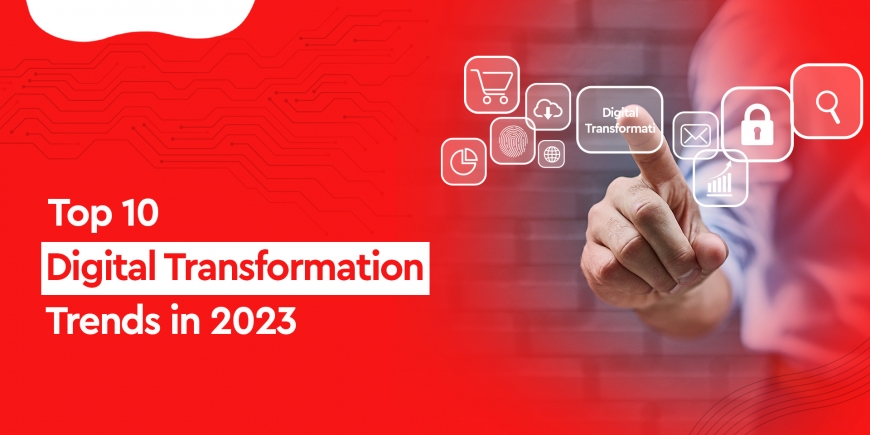Top 10 Digital Transformation Trends in 2023
As we begin this new year, it’s thrilling to consider how technology is transforming our world and altering the way we live and operate.
The possibilities are boundless, from virtual reality to AI-powered automation.
So grab a coffee, and let’s explore the technological future together!
But before we do, let’s first clear up some definitions:
What is Digital Transformation?
From a corporate perspective, digital transformation is the use of cutting-edge technology and digital experiences to improve business processes, objectives, and strategies while enhancing workflow and customer experiences. To surpass consumer expectations in 2023, a digital transformation journey is necessary. By enhancing customer journeys, digital trends may assist determine corporate strategies and business outcomes.
According to Gartner, it is a “process of exploiting digital technologies and supporting capabilities to create a robust new digital business model.”
However, there’s still one more crucial query: Why should your company become digital?
A quick fact: The market for digital transformation was valued at $731.13 billion in 2022 and is projected to expand at a CAGR of 26.7% through 2030.
Why?
Because it’s what drives corporate growth.
Imagine this.
In essence, digital transformation is about combining all of your tools so that you can compete successfully in the big league with your rivals.
The more often you use it, the more likely you are to be the last one standing.
However, if you are unaware of the trends, it will be useless.
In light of this, let’s examine the top digital transformation trends for 2023.

1- Wider adoption of low-code platforms:
A development environment known as a low-code platform allows non-technical business users to create, develop, and deploy software applications. Business analysts and other non-technical users can design and develop unique solutions without coding because of the graphical user interface and drag-and-drop features it offers.
The advantages low-code platforms provide in terms of time, money, scalability, and risk reduction have led to a surge in their adoption in recent years. These advantages have spawned fresh application cases like
1) Rapid prototyping
2) Rapid deployment
3) Product development
We predict that as these solutions advance, businesses will adopt them faster because they will be able to assess certain digital products’ viability in their ecosystems more swiftly.
2- Increased migration to the Cloud:
Cloud technologies are being used by businesses more and more, especially when it comes to cost-cutting, enhancing accessibility, and outsourcing tiresome everyday maintenance labor.
As technology advances and internet connections increase, especially in countries where they have historically been slow, more organizations will switch to the cloud to take advantage of all the distinct benefits they offer.
Businesses that deal with sensitive data need to start using cloud technologies, but to do so, cloud technology providers must overcome a formidable obstacle: tightening up their security framework.
3- AI and Machine Learning:
The two key technologies for digital transformation are AI and ML. Artificial Intelligence is significant because it offers insights into consumer behavior, demographics, and preferences that enable businesses to make better decisions. ML is crucial because it enables businesses to leverage data to develop individualized client experiences.
These two technologies are increasingly being incorporated into business software to help organizations build the intelligence required to relieve employees from tiresome tasks and support senior management in making deft decisions.
4- Intelligent Search:
Intelligent Search uses AI technologies including machine learning, computer vision, semantic search, and natural language processing to give users more precise and individualized search results. It dismantles the data silos that exist in enterprises and makes it possible to pull information from essentially any data source.
In addition to offering a single point of access to enterprise content sources and the ability to deliver better results more quickly, search intelligence enables the enhancement, searching, and analysis of data in both organized and unstructured formats.
Employees look for and gather information for an average of 1.8 hours each day, or 9.3 hours per week.
5- Automation:
When examining the trends for the coming digital transformation, automation is one of the key components.
Business process automation solutions help firms speed up the completion of internal procedures by removing the need for human execution. These technologies have the potential to boost output in the medium to short term, improve customer satisfaction, and digitize business processes; but, they do come with a learning curve that must be overcome before any project can get off the ground.
More than 80% of business executives claim that they are expanding their use of remote workers and speeding up work process automation. The best way to speed up automation is to use the appropriate business process automation technologies, which can help deliver faster results with less coding knowledge.
When automation is combined with tools such as digital signature software and contactless payment methods, it will alter the daily operations of your business.
6- Increased investment in Blockchain:
Blockchain is a new technology that can be used in a variety of industries, including finance, healthcare, and supply chain management. It has the potential to disrupt the traditional way of doing business in many sectors by allowing us to create smart contracts and permanently store records that cannot be tampered with.
Because software vendors require a more secure environment to prevent sensitive information from being leaked to the public, this technology is regarded as an important component in the list of digital transformation trends to watch for.
7- Virtual business collaboration:
The COVID-19 pandemic was one of the worst things that could have happened to us in the last two years, but it has had a significant impact on businesses’ decisions to begin using or aggressively adopting digital technologies.
Businesses realized they couldn’t function while their employees worked from home, so they increased their investment in digital software that enables virtual collaboration, whether it’s team collaboration tools or document collaboration tools.
We expect to increase our investment in creating a virtual collaboration environment that is even better than working from your company’s offices.
8- Customer Data Platforms:
A customer data platform is a technology that connects various applications and databases in order to provide customer-centric data and analytics.
Customer data platforms are used to manage customer information, analyze customer trends, identify future marketing opportunities, and create more personalized customer experiences.
Customer data platforms allow you to consolidate all of your customer information from various sources into one location so that you can make better decisions.
9- Everything as a Service (XaaS):
XaaS is a new business model that is gaining popularity. It stands for Everything as a Service and is a method of providing customers with the software on demand. This model is an extension of the SaaS (Software as a Service) model, which provides internet access to applications.
The XaaS model provides access to a variety of services from a single provider, such as infrastructure, data storage, and processing power.
Amazon Web Services, a cloud computing platform that provides cloud computing services to its customers, is an example of a XaaS company.
10- Change Management:
The most important trends in change management in the context of digital transformation are early employee buy-in and engagement, as well as training, effective technology utilization, digital ID&V methods, digital payments, and the adoption of agile methodologies. To aid in the change management process, organizations must carefully implement these trends.
Conclusion:
Digital strategies and digital trends enable businesses to engage in digital transformation and succeed in business transformation.
Whatever the trends are, the key takeaway is to consider how they align with business objectives and use only those that are relevant to your company.
Otherwise, you may incur costs where you should be saving.
222 total views
There are no comments



